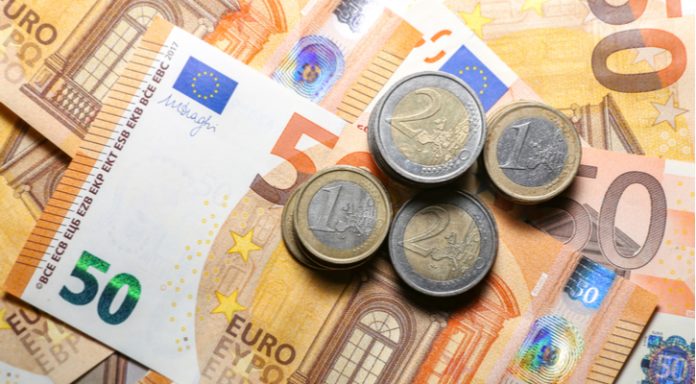 |
In a strong European session on Thursday the euro struck a peak of US$1.1097, before trending steadily lower across the US session. The euro US dollar exchange rate closed Thursday down 0.1% at US$1.1060. The pair is trading within a familiar range in early trade on Friday,
All eyes this morning will be on the new European Central Bank President Christine Lagarde as she gives her first proper speech as the head of the ECB. She is now three weeks into her new role and has yet to discuss her views on the path of interest rates or the eurozone economy, which has weakened over recent months. However, it is worth noting that Christine Lagarde may have her hands tied as far as monetary policy is concerned given that around a third of the European Central Bank Governing Council already oppose further easing.
Eurozone PMI Figures To Fuel Concerns Over Recovery?
Euro investors will now look ahead to a slew of pmi releases. Analysts are expecting that pmi readings across the board improved in October. The manufacturing sector is still expected to be in contraction for both the eurozone and Germany, however the pace of contraction is expected to have eased. Analysts forecast eurozone manufacturing pmi to print at 46.4 in October, up from 45.9 in September. German manufacturing pmi is expected to tick up from 42.1 in September to 42.9 in October. 50 is the level that separates expansion from contraction. Whilst the numbers are expected to move in the right direction, at these levels the manufacturing sectors would still be in deep contraction.
The manufacturing sector in Germany, most notably, has been caught in the crossfire of the US — China trade dispute. As an exporter nation Germany has felt the effects of slowing global trade and declining confidence. Brexit has also negatively impacted on the manufacturing sector in Europe’s largest economy.
Whilst a slowdown in the manufacturing sector is far from ideal, the service sector is the dominant sector in the eurozone. Investors will be watching the service sector pmi figures for Germany and the eurozone closely for any signs that the slowdown in manufacturing is spilling over into the service sector. Eurozone service sector pmi is expected to tick higher to 52.4 in October, up from 52.2. Activity in the German service sector is also expected to inch high to 52, up from 51.6.
Trade Still Stealing The Show
The US dollar shook off early weakness on Thursday to advance against most of its peers in the US session. Dollar investors remained focused on the latest US — China trade developments after 16 months of elevated tensions between the two economic powers which has weighed on the global economy.
Once again risk sentiment seesawed on Thursday as trade headlines to and fro-ed giving mixed messages as to whether the US and China would be able to achieve a first phase trade agreement. The optimism of recent weeks is starting to fade as rhetoric between the two sides hardens.
The main headlines came from South China Morning Post, an article stated that China would not make a deal with President Trump, if the US President signed the Hong Kong bill into law. However, the article also said that the US could be prepared to delay tariffs due to take effect on 15th December, even if a deal wasn’t in place. This followed earlier news that Chinese Vice Premier Liu He said that he was confident about reaching phase one of a deal with the US.
These headlines from just one day show how contradictory news flow is, and the dollar is very trade dependent right now.
Existing Home Sales Jump
On the macro data front, strong US existing homes sales also offered some support to the dollar. Us home sales increased by more than expected in October and house prices rose at the fastest pace in more than two years, thanks to lower mortgage rates and a shortage of properties on the market. The data comes after the Federal Reserve has cut interest rates three times this year bolstering the housing market a good sign for the economy.
Could PMI Data Lift Dollar?
Today US — China trade headlines will continue to drive movement in the dollar. The dollar could also get a boost from US manufacturing PMI. Analysts expect activity n the US manufacturing sector to tick higher at 51.4 in October, up from 51.3 in September as the sector continues to rebound from a slump at he end of the summer. The level 50 separates contraction from expansion.
The service sector is also expected to show a marked improvement with activity increasing to 51.4, up from 50.6. A print at this level could calm investors fears of the slump in manufacturing spilling into the service sector. The data would be more supportive of the Fed’s assessment of the US economy, that it is recovering.
Finally, US confidence data from the University of Michigan will also be under the spotlight. Investors are expecting sentiment to remain steady for a second straight month at 95.7.
 |
| What do these figures mean? |
| When measuring the value of a pair of currencies, one set equals 1 unit and the other shows the current equivalent. As the market moves, the amount will vary from minute to minute.
For example, it could be written: 1 EUR = 1.12829 USD Here, €1 is equivalent to approximately $1.13. This specifically measures the euro’s worth against the dollar. If the U.S. dollar amount increases in this pairing, it’s positive for the euro. Or, if you were looking at it the other way around: 1 USD = 0.88789 EUR In this example, $1 is equivalent to approximately €0.89. This measures the U.S. dollar’s worth versus the euro. If the euro number gets larger, it’s good news for the dollar. |





